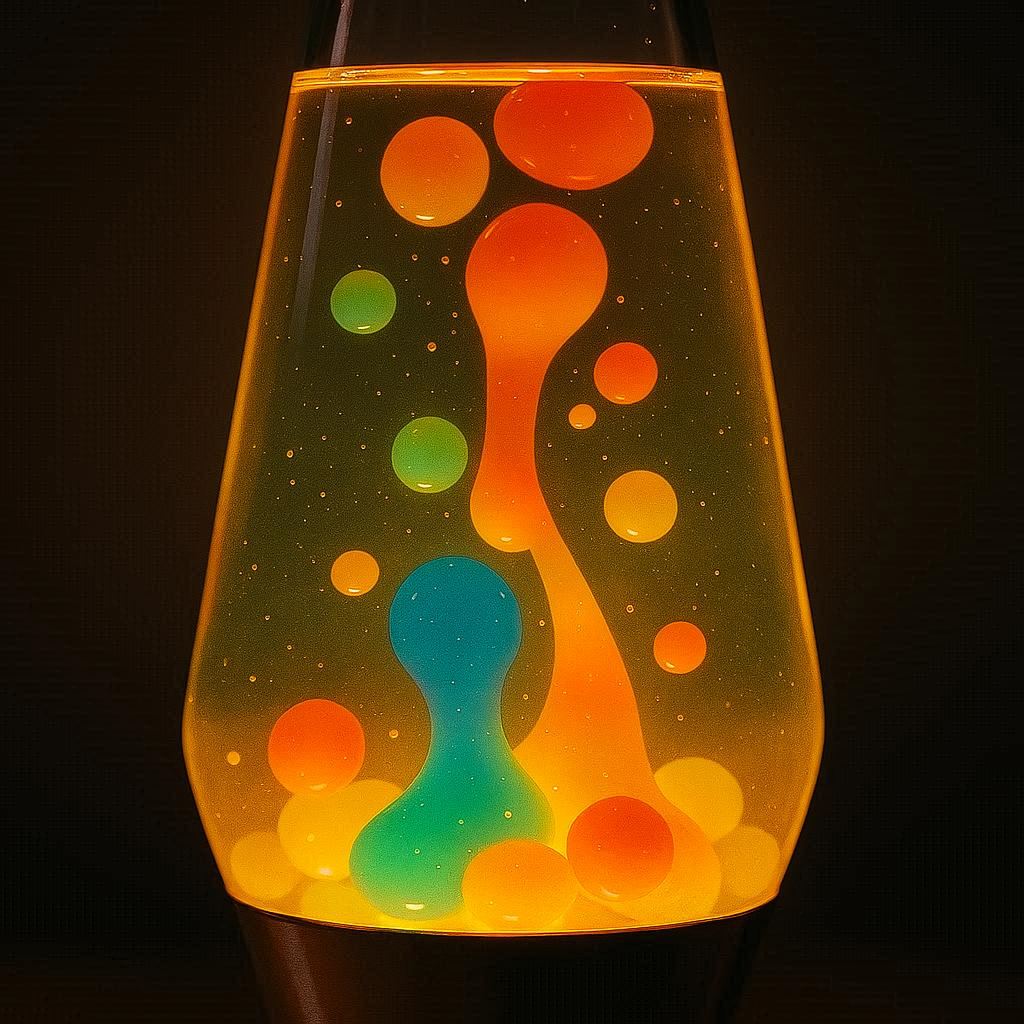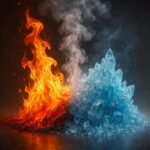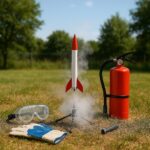Creating a homemade lava lamp is a fun and educational DIY project that captures the magic of density and buoyancy. This enchanting science experiment allows you to observe colorful, swirling patterns created by the interaction of oil, water, food coloring, and effervescent tablets. By crafting your own lava lamp, you can gain insights into fundamental physics concepts like density and buoyancy while enjoying a mesmerizing visual display. In this blog post, we’ll delve into the physics behind this phenomenon and guide you through the process of making your own homemade lava lamp.
Materials Needed
Before we dive into the physics, let’s gather the materials you’ll need for this experiment:
- A clear glass or plastic bottle with a tight-fitting lid (2-liter soda bottles work well)
- Vegetable oil (or another dense oil)
- Water
- Food coloring
- Alka-Seltzer tablets (or another effervescent tablet)
- Glitter or small beads (optional, for extra visual effect)
- A dropper or straw (optional, for controlled droplet release)
The Homemade Lava Lamp Experiment
Step 1: Prepare the Bottle
Start by cleaning and drying the bottle thoroughly. Remove any labels and ensure the inside is clear for visibility.
Step 2: Add Oil and Water
Fill the bottle approximately three-quarters of the way with vegetable oil. Then, slowly pour water into the bottle until it’s about 90% full. Be careful not to mix the two liquids yet. The oil and water will naturally separate because oil is less dense than water.
Step 3: Add Color
Add a few drops of food coloring to the water. The color will mix with the water but remain separate from the oil, creating a layered effect.
Step 4: Introduce Effervescence
Break an Alka-Seltzer tablet into small pieces and drop them into the water. You’ll immediately see bubbles forming and rising through the oil. This is where the lava-like effect begins to take shape.
Step 5: Enhance the Visuals
If you’re using glitter or small beads, add them to the water before dropping in the Alka-Seltzer tablets. The glitter will swirl alongside the bubbles, adding more visual interest to your homemade lava lamp.
Step 6: Observe and Enjoy
Watch in awe as the colorful, bubbly mixture creates a mesmerizing display. The density difference between the oil and water, combined with the buoyant force from the bubbles, creates the lava-like effect. You can repeat the process by adding more Alka-Seltzer tablets once the bubbles subside.
Understanding the Physics Behind the Homemade Lava Lamp
The homemade lava lamp effect is rooted in the principles of density and buoyancy. Let’s break down the science step by step.
Density: The Foundation of the Effect
Density is a measure of mass per unit volume. In this experiment, vegetable oil is less dense than water, which is why oil floats on top of water when the two are placed in the same container. When you add food coloring to the water, it remains in the denser layer below the oil.
The Alka-Seltzer tablets react with water to produce carbon dioxide gas, which forms bubbles in the water. These bubbles attach themselves to the colored water droplets, reducing their overall density and causing them to rise through the oil. As the bubbles reach the top of the oil layer, they pop, releasing the colored water droplets back into the denser water below. This continuous cycle creates the lava-like effect.
Buoyancy and the Role of Bubbles
Buoyancy is the upward force exerted by a fluid on an object submerged in it. According to Archimedes’ principle, the buoyant force is equal to the weight of the fluid displaced by the object. In this experiment, the bubbles produced by the Alka-Seltzer tablets create buoyant force by displacing the surrounding water. This force lifts the colored water droplets upward through the oil.
When the bubbles reach the oil layer, they continue to rise due to the reduced density of the oil compared to the water. The oil layer allows the bubbles to rise more freely, creating the flowing, lava-like motion of the colored water.
The Role of Surface Tension
Surface tension also plays a role in this experiment. Surface tension is the energy that causes the surface of a liquid to behave as if it has an elastic membrane at its surface. In the homemade lava lamp, surface tension helps maintain the separation between the oil and water layers. It also affects the formation and rise of bubbles in the water layer.
Light Play and Visual Effects
The visual appeal of the homemade lava lamp is enhanced by the interaction of light with the oil, water, and bubbles. Light refracts, or bends, as it passes from one medium to another. When light passes through the oil, water, and bubbles, it creates a range of visual effects, including the colorful, swirling patterns we see in the lava lamp.
The way light interacts with the different layers and bubbles adds to the mesmerizing effect. The oil layer acts as a medium through which light travels before reaching the water and bubbles. The refractive properties of the oil and water, combined with the reflective properties of the bubbles, create the illusion of flowing, molten rock.
Fun Variations and Experiments
The homemade lava lamp experiment can be modified and expanded upon to explore different scientific principles. Here are a few ideas for fun variations:
1. Different Liquids and Colors
Experiment with different types of oil and liquids to see how they affect the lava lamp effect. For example, you can try using corn syrup, honey, or other viscous liquids instead of water. You can also experiment with different colors and combinations of food coloring to create unique visual effects.
2. Layered Liquids
This experiment can be extended by creating a layered liquid density column. By adding multiple layers of different liquids, you can observe the relative densities of various substances. For example, you can layer honey, corn syrup, vegetable oil, and water in a tall glass to see how they separate based on density.
3. Bubbles and Buoyancy
Explore the role of buoyancy in the lava lamp effect by experimenting with different types of tablets or substances that produce gas. For example, you can try using baking soda and vinegar to create bubbles instead of Alka-Seltzer tablets. This can help you understand how different chemical reactions produce gas and affect buoyancy.
4. Sound and Vibration
Add a musical element to the experiment by placing the lava lamp on a speaker or vibrating surface. The vibrations will cause the bubbles and colored water droplets to move in time with the music, creating a synchronized light and sound show.
5. Glow-in-the-Dark Effect
Create a glow-in-the-dark lava lamp by adding glow-in-the-dark paint or glow sticks to the water layer. This will make the experiment even more visually striking and allow you to observe the lava lamp effect in the dark.
Safety Tips and Precautions
When conducting the homemade lava lamp experiment, it’s important to take a few safety precautions to ensure a safe and enjoyable experience:
- Alka-Seltzer tablets can be slippery when wet, so handle them carefully to avoid dropping them.
- If you’re using a glass bottle, be cautious not to drop it, as broken glass can be hazardous.
- Keep the experiment away from young children who may try to ingest the materials.
- If you’re using glow-in-the-dark materials, ensure they are non-toxic and safe for use in the experiment.
Conclusion
The homemade lava lamp is a fascinating science experiment that combines density, buoyancy, and light play to create a mesmerizing visual display. By understanding the physics behind the experiment, you can appreciate the scientific principles at work and gain insights into the behavior of different liquids and gases. Whether you’re a student, a teacher, or simply someone who loves science, this experiment offers a fun and educational way to explore the wonders of physics in the comfort of your own home.
This blog post provides a comprehensive guide to creating your own homemade lava lamp and understanding the physics that make it work. With a few simple materials and some basic knowledge of density and buoyancy, you can create an enchanting display that captures the magic of science in motion.



